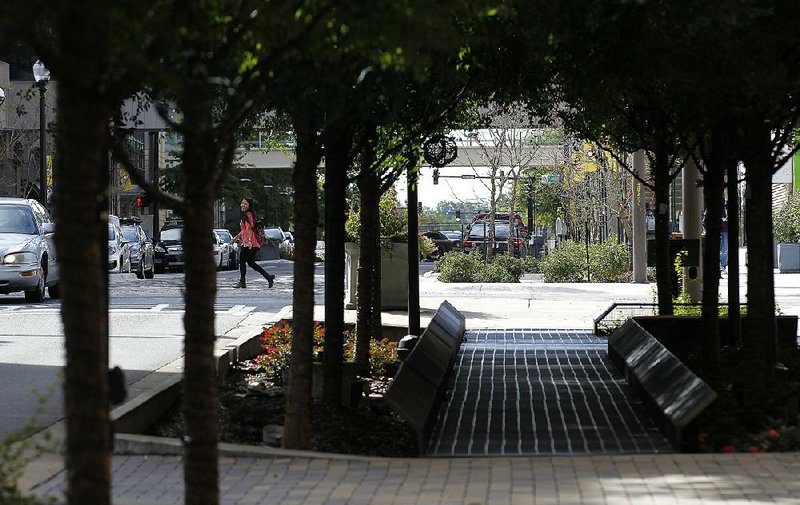A water-quality project on Little Rock's Main Street that aims to make the downtown business and arts district a little bit greener has expanded by two blocks.
The second phase of a streetscape development plan targeting water runoff consisted of construction of the "rain gardens," porous pavers and a vegetative wall that now line the 600 and 700 blocks of Main Street. It was completed late last month.
A $536,500 grant from the U.S. Environmental Protection Agency, which Little Rock obtained through the Arkansas Natural Resources Commission, funded the project, said Caran Curry, the city's grants manager.
The first phase, which was completed in 2015, covered the 100, 200, 300 and 500 blocks of the street. That project cost about $2 million, with an EPA grant paying for $900,000 of it and the city covering the rest.
At an event celebrating the project's completion Wednesday, Tony Ramick, fiscal grants manager for the Arkansas Natural Resources Commission, noted that the project is not necessarily a holistic approach to improving water quality. Instead, it's a space for new eco-friendly ideas to be tested out in public, on display for visitors or for schoolchildren to learn from.
"It's a great demonstration project on low-impact design," Mayor Mark Stodola said.
The new features are similar to those in the first phase, but Ramick said some have been improved upon based on what the team learned.
In both phases, workers replaced asphalt with porous pavement that allows excess stormwater to flow through it. The water runs into "rain gardens," patches of soil with plants that treat and filter the water, making the runoff that makes its way into the Arkansas River cleaner. Ramick said the team changed the drainage design slightly to improve filtration.
In the project's second phase, the system included a sand filter, trash guards, skimmers and inlet filter sacks at strategic locations to further improve water quality, said Marsha Guffey, the project's coordinator.
"The system of rain gardens and filters used all work together to form a treatment chain that greatly improves the quality of water runoff before it leaves the project site," Guffey said in an email.
The second phase also includes a new kind of vegetative wall near Main and Eighth Streets -- a wire structure with semi-evergreen plants climbing on it. Ramick said that feature improves air quality and cools the area.
Workers also added a ballot bin, a yellow box that encourages people to use their cigarette butts to vote on a lighthearted topic, rather than dropping them on the ground. On Wednesday, those discarding waste could choose to cast a vote for Batman or Superman.
Curry said the city has no immediate plans for a third phase but hopes to continue the project in the future.
At Wednesday's event, Stodola said the revitalization of the once-deserted street has been his mission since he took office in 2007.
Metro on 10/18/2018

